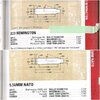Here is my understanding of the difference between .223 Remington and 5.56x45mm NATO...
- NATO rounds are loaded to a higher max pressure for the same bullet weight (the actual pressure measurements are different between NATO and SAAMI). NATO rounds are "hotter".
- NATO cases tend to have (but not always) thicker walls while the external dimensions are identical to to .223 Rem. This means smaller internal volume for the powder. All else being equal, loaded with the same powder charge a NATO cases will generate higher pressures because of the smaller case volume.
- The 5.56x45mm NATO chamber has a longer lead (aka. throat length = distance the bullet needs to jump before reaching the rifling). This extra room in the NATO chamber allows the building pressure of the ignited powder some room to grow before the bullet meets the resistance of the rifling. It also makes the NATO chamber more reliable in dirty conditions.

All of the above reasons ADD to the chamber pressure when firing a 5.56 NATO round in a .223 Rem... see below why you DON'T want to do this.
The info I'm referencing comes from this page:
https://gundigest.com/gear-ammo/reloading/ar-15-basics-223-vs-5-56x45-nato
A quote from that page about using XM-193 NATO rounds in a NATO test chamber and a .223 Rem test chamber:
In the 5.56 test barrel, the XM-193 produced 48,000 PSI. A little on the low side, but since it delivered the expected velocity, why should Federal have loaded it any hotter? In the .223 barrel, the same ammo produced 62,000 PSI.
What you DON'T WANT to do:
- DO NOT use factory 5.56 NATO cartridges in a .223 Rem chamber. It is OKAY to use .223 Rem cartridges in a NATO chamber.
- DO NOT use .223 Rem max load data in 5.56 NATO cases w/o first working up your loads. The smaller NATO case volume could result in over pressure. A powder charge that is max safe pressure in a .223 Rem case fired in a .223 Rem chamber may cause over pressure when used in a NATO case.
- DO NOT use 5.56 NATO max load data in a .223 Rem case. The max pressure of a NATO cartridge may still exceed a .223 Rem SAAMI cartridge spec. Some .223 Rem cases actually have smaller internal volumes than NATO cases. Don't assume case volume by make alone.
SO...can I load 223 cartridges, using 223 data, into 5.56 brass (range brass pick-ups. My range is literally carpeted with the stuff; it's actually annoying.) and expect acceptable results? (Obviously, I wouldn't load using 5.56 data into a 223 case.)
Since you have a NATO chamber you can use either factory .223 Rem or factory 5.56 NATO boxed cartridges.
I suggest you sort your cases not only by NATO or .223 Remington, but group by batch/make. I split my LC cases into different piles by the year... LC14 in one pile, LC15 in another. FC cases in another pile; etc. I do this more for better consistency by loading the same charges in similar case batches. If you are looking for precision this is an easy way to get somewhat consistent cases. If these are plinking loads, you do not need to be anywhere near max charges. Keep the charges lower and the same charge can be used in either type cases... after you have worked up the charges in the different cases.
When reloading always work up the charges looking for pressure signs on the fired cases. Start from the suggested starting charge weight or 10% below the max charge... which ever is LOWER. Use load data from multiple sources when possible and consider starting with the LOWEST recommended charges for a given bullet weight! Start low and work your way up. This rule works for any cartridge and bullet weight.
Be careful with the Hodgdon site load data. It tends to be hotter than Hornady load data.
I recently started loading for .308 Win and found that my max charge (worked up my load using 7.62 NATO LC cases) was BELOW the starting charge suggested by the Hodgdon site. The Hodgdon starting charge was only around 6% lower than the listed Max charge. In the end, my Max charge ended up being around the 10% below Max point... 4% below the Hodgdon recommended STARTING charge. The Hornady Max charge for the same weight bullet was BELOW the Hodgdon STARTING charge! This taught me to start closer to the LOWEST recommended starting charge load data I could find.




